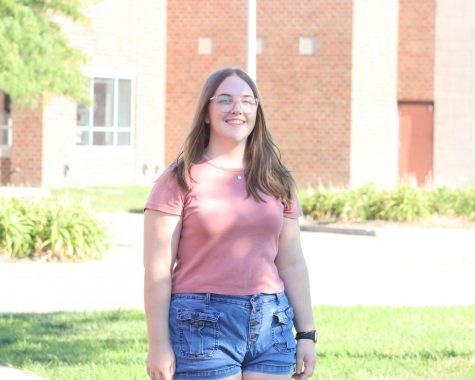Omaha’s long history of police brutality
It’s time to confront the city’s problem with state-sanctioned racial violence
photo courtesy of Omaha World-Herald
Omaha police fire pepper balls at protestors at a Black Lives Matter protest over the summer of 2020.
April 20, 2021
A horde of protestors gather and chants pierce the air on Farnam Street. A sea of signs reading “we stand with Kenosha,” “defund OPD” and “Black Lives Matter” held by protesters calling out police brutality is met with increasing police presence.
Over the speaker, police officers, who were peacefully escorting the group just minutes before, tell protestors to disperse. They threaten to deploy tear gas. They reach for the weapons on their uniforms.
“This is the Omaha Police Department. This has been declared an unlawful assembly. You are all subject to arrest.”
Court documents later reveal that the majority of protesters did not hear the order to disperse. As the group reaches the Farnam Street Bridge, cruisers roll up behind them and trap them. Officers rip signs out of protestors’ hands. Pepper balls, tear gas, and flash grenades are launched. A flash grenade hits someone in the head, a tear gas canister is fired from point-blank range by an officer, and another tear gas canister severely burns a protestor’s leg.
That night, police detain 128 people on nonviolent charges. Detainees sit, hands zip-tied together, on the bridge for two hours before they are taken to the correctional facility, where they wait in the parking lot for another four hours.
This scene is a picture of Omaha in July 2020, a shock wave triggered by police brutality and the murders of multiple Black Americans: Rayshard Brooks, George Floyd, Breonna Taylor, Daniel Prude. It is the culmination of decades of racial violence at the hands of law enforcement.
The streets of Omaha have seen this play out dozens of times before. In 1969, 51 years before Omaha’s 2020 Black Lives Matter protest, Omahans rife with anger over the murder of Vivian Strong took to the streets.
Fourteen-year-old African American Vivian Strong was spending her Tuesday night the way many teens in Omaha were that summer; she was practicing her dance moves in hopes of being featured on Seven Swings, a local television program. Vivian, along with her sister and a few friends, were practicing in a vacated unit at a housing project in Omaha.
When the police arrived at the scene, responding to a report of a break-in, the group scattered. James Loder, a white responding officer, issued no warnings before drawing his gun and firing. Vivian Strong was shot in the head. That night, people stormed the streets of Omaha in protest.
In a trial that drew national attention, officer James Loder faced up to 10 years in prison for the murder of Vivian Strong. The trial lasted eight days. In the end, an all-white jury acquitted Loder of manslaughter. After the acquittal, Loder returned to the police force and served for two more years.
In the Near North Side, a community known for its vibrancy, small businesses, and love of Jazz, a little girl was shot for dancing. The legacy of this violence lingers in the streets of Omaha. It deepened a wound that has impaired the city since the lynchings of Black people like George Smith and Will Brown. It reignited terror in a group of people who have been victimized by this type of brutality for centuries in America, and it further eroded the trust between Black Americans and law enforcement.
When James Loder’s African American police partner, James Smith, and Vivian’s sister, Carol, asked why he shot Vivian, they were met with silence. Decades of racial violence and police brutality provide the answer that Loder wouldn’t; James Loder shot Vivian Strong because he had the power to do it. He did it because he knew he would get away with it, given the established pattern of police acquittals in America. He did it because he had been raised in a country and trained in a workforce that operates under a rigid racial caste system.
Police brutality hides under the cloak of justice while functioning as a demonstration of white supremacy’s grip on American society. Even while they fire pepper balls, unleash tear gas, pull out batons and shoot guns, officers can use the cover of preserving public safety. They have been given absolute power and protection from accountability.
In the days and weeks following Loder’s acquittal, Omaha’s Near North Side saw looting, burning and continued police brutality. The chants in the street during the protests in 1969 and 2020 are not just angry calls for reform. They are cries that mourn the loss of the victims of white supremacy. They are desperate grasps at justice in a system that acquits white people for inflicting violence and ignores Black people when they ask why.
The police force was created to protect property, not people. In the North, it functioned as a for-hire system that allowed wealthy citizens to protect their land and possessions. In the South, it functioned as slave patrol. To this day, it operates fundamentally under a caste system that values property over human lives. This is the caste system under which the construct of criminality has been designed. That is why Omaha’s police force believes teenagers partying is a crime worthy of death, and they believe peacefully marching on the street is a crime worthy of being physically attacked.
Ultimately, long-lasting change will only be brought about on the systemic level. Bias training, body cameras, chokehold bans and the multitude of other popular suggestions for police reform are important short-term, but they won’t do anything to dissolve the racist caste system and myth of white supremacy. The only way to do that is to divest from the current system and invest in alternative forms of public safety. To deal with the root of the problem, there needs to be a redirect of not only public funds, but also time, energy and resources into programs that focus on increasing equity in K-12 education, reducing food insecurity and generational poverty, and addressing homelessness, mental illness and substance abuse. These community-based changes can play a major role in reconstructing the modern view of criminality and can help break down the current caste system by confronting the gaps in education, economy and well-being that exist as a result of America’s long history of racism.
Police brutality has plagued Omaha for decades. It is used as a weapon against marginalized communities and a suppression tactic against protests. It’s long past time for the city and the community to finally confront the epidemic of state-sanctioned racial violence.







